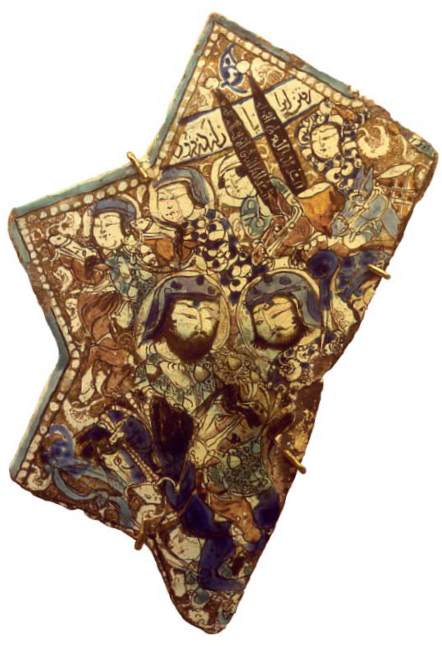
History has not been kind to Shawar Ibn Mujir. He was one in the line of military wazirs who dominated the Fatimid army, state and to a great extent even the caliph himself from the 1130s onwards. They are usually regarded as symbols of the degeneracy of the Fatimid state. According to the Israeli historian Yaacov Lev, the weakening of the Isma’ili Shia imam or caliph in relation to these chief wazirs stemmed from changes in the structure of the Fatimid army. These were above all the introduction of an ‘iqta system of military fiefs – taken even further by Saladin – and alterations in the recruitment patterns of the ‘abid, which were largely Sudanese infantry regiments of the caliphal guard.

‘Iranians leaving the castle of Furud’, an episode in the epic Persian Shahnamah poem on a late 12th-century Kashan-ware tile, probably from a palace. (Museum of Fine Arts, Boston; author’s photograph)
Shawar first came to prominence as an Arab governor of Sa’id, the part of Upper Egypt from which he got the name al-Sa’idi. His main support base was amongst the local people of this region and especially the Bedouin Arab tribes, who remained a powerful force in Egypt, especially in the south where they formed a local aristocracy. With this southern-Egyptian army at his back, Shawar rebelled against the existing wazir, Ruzzayk, whom he overthrew, and was then himself installed as wazir by the virtually powerless young Fatimid Caliph al-’Adid in December 1162. In the chaotic conditions of Egypt at the time, Shawar had to rely upon several other powerful men, including his ruthless sons Tayy and al-Kamil, his chief military commanders Yahya Ibn al-Khayyat and ‘Abd al-Rahman al-Baysani from Palestine and also upon a powerful political figure in the Fatimid court, the Nubian eunuch al-Mu’tamin al-Khilafah.
Although he was only wazir of the Fatimid state for a few years, Shawar attempted to govern an almost impossible situation. Both the Crusader Kingdom of Jerusalem and Nur al-Din, the increasingly powerful ruler of Syria, wanted to dominate and perhaps even take over Egypt. Shawar’s own preference seems to have been for an alliance with the Crusaders, though when this failed he is said to have considered a marriage alliance between Saladin, who was Nur al-Din’s representative in Egypt, and his own daughter. This rumour was nevertheless strongly denied by all concerned.
At various times Shawar attempted to ally himself with, and to fight against, both Sunni Muslim Syrians and Catholic Christian Crusaders. Despite his best efforts, he failed, and as a result was almost inevitably overthrown in August 1163 by a new wazir, Dirgham. Shawar regained power not long after and remained wazir until his assassination in 1169. Unfortunately Shawar was remembered not only for his various military defeats, notably by Shirkuh and Saladin at the battle of al-Babayn, but also for destroying much of his own capital in 1168. In fact this destruction was almost certainly exaggerated by chroniclers eager to denigrate the unfortunate Shawar. Nevertheless it illustrated a degree of ruthlessness or perhaps desperation on his part.
The Crusaders had taken and sacked the fortified town of Bilbays on the eastern edge of the Nile Delta before pressing on to attack Cairo itself. Here the old capital of Fustat, on the southern edge of the Fatimid caliphal palace-city of al-Qahira (Cairo) is said to have been burned on Shawar’s orders in order to stop its wealth falling into enemy hands. Historians have tended to see the destruction of Fustat in November 1168 as a seminal moment in the history of the Crusades. However, recent archaeological studies indicate that the devastation was by no means as extensive as once thought. There had been several fires over a number of years and the entire urban area had probably been in decline since the appalling Egyptian famines and plagues of 1066–72. An area along the east bank of the river Nile continued to flourish but it seems that any revival or expansion of the inhabited area was southward and westward, onto land left by a gradual shifting of the Nile itself. The fate of the eastern quarters remains unclear and the ruins through which Saladin later built his defensive wall had probably been abandoned by this time. Furthermore, the complete burning of 12th-century Fustat would have had a cataclysmic economic and social impact for which there is no real evidence.
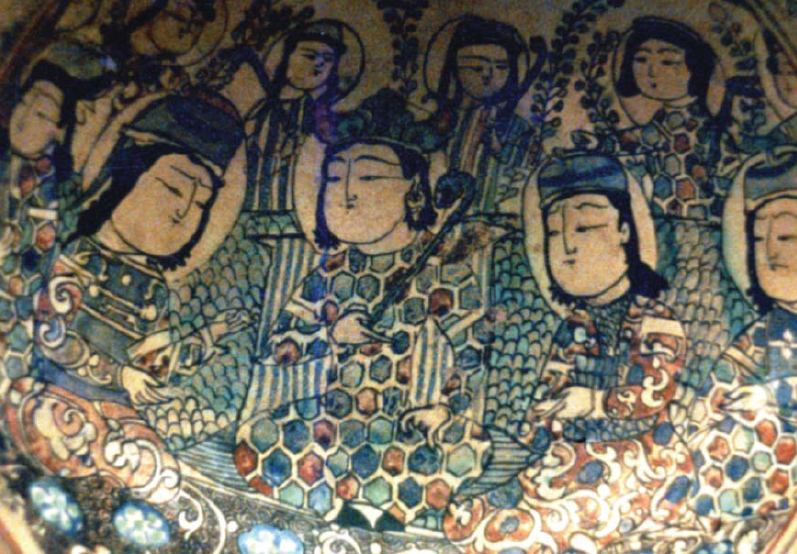
The ruler on this minai-ware bowl from 12th- or early 13th-century Iran carries an animal-headed mace. Another man has a mail shirt beneath a lamellar cuirass while the man on the left probably wears a form of cloth-covered armour. (Museum of Fine Arts, Boston, author’s photograph)
Because Saladin was such a dominant figure in the Islamic regions facing the Crusader states in the latter part of the 12th century, his contemporaries and rivals have tended to be overlooked. Many of them also became his allies, having failed to contain the expansion of Saladin’s power. One such leader was Mas’ud Ibn Mawdud Izz al-Din, also known as Mas’ud I. He was one of the great ‘Imad al-Din Zangi’s grandsons, ruling a Zangid state centred upon the northern Iraqi city of Mosul from 1180 to 1193. The Syrian branch of the Zangid dynasty had been absorbed by the Mosul branch soon after the death of Nur al-Din, but this brought them up against the rising power of Saladin. Although the Egyptian sultan twice failed to conquer Mosul, once in 1182 and again in 1185, Mas’ud Ibn Mawdud did accept his nominal suzerainty in 1183.
Even before he became ruler of Mosul, Mas’ud Ibn Mawdud Izz al-Din had faced Saladin in battle. This was, in fact, a particularly interesting clash at the Horns of Hama, the name of which seemed to be a foretaste of Saladin’s greater victory at the Horns of Hattin. It was fought on 13 April 1175 and pitted Saladin’s largely Egyptian-based army, plus troops from recently conquered Damascus, against the Zangid army of Mosul from northern Iraq. Generally speaking it seems that troops from Syria, and perhaps also from Egypt, had greater military experience than those of the regions ruled by Mosul and its allies.
According to some sources the army of Mosul had been arrayed by ‘Izz al-Din, the brother of Ghazi II Sayf al-Din who then ruled Mosul. The latter was also advised by a senior amir named Zulfandir. At first it looked as if both sides had deployed in a highly conventional manner, each with a centre and two wings. However, while Saladin commanded his own centre, he had also hidden reserves behind a nearby tall, or small conical hill, which marked the site of an ancient settlement. According to the contemporary chronicler Ibn al-Athir:
They met on 19 Ramadan [13 April 1175] near the city of Hama at a place called the Horns of Hama. Zulfandir was ignorant of military matters and fighting, unaquainted with their practice, in addition to being a coward, although he had been granted good fortune and favour by Sayf al-Din [ruler of Mosul]. When the two sides met, Sayf al-Din’s force did not hold firm but fled, every man looking out for himself. Sayf al-Din’s brother, ‘Izz al-Din, stood firm after the rout of his men. When Saladin saw his steadfastness, he said, ‘Either this is the bravest of men or he has no knowledge of warfare’. He ordered his men [probably the hidden reserves] to charge him, which they did and drove him from his position. Their rout then became complete.9
Other descriptions of this one-sided battle state that Saladin’s troops forced the enemy away from ‘their baggage, their beasts and their infantry’, which seems to be another reference to the sudden flanking attack by hidden reserves. Large numbers of prisoners were taken, and Saladin followed the advice of generations of Muslim military theoreticians by not allowing them to be harmed. He was fully aware that these men might well be future allies, or even members of his own army. Such large numbers of horses were also captured at the Horns of Hama that Saladin’s foot soldiers reportedly became mounted infantry.
Sometimes known as ‘The Elephant of Christ’, Reynald of Châtillon tends to be seen either as a romantic hero who showed astonishing strategic vision, or as a bloodthirsty bandit warped by years as a prisoner-of-war in a Turkish dungeon. He was undoubtedly brave and good looking. Having arrived in the Crusader states from France without wealth or many followers in 1153, Reynald of Châtillon won the hand of Princess Constance of Antioch. However, he was captured by the Muslims and spent the years 1161–75 as a prisoner in Aleppo. This left him with a burning hatred for Islam, but also a deep knowledge of the culture of the Islamic Middle East. In subsequent years the Muslims were correct in viewing Arnat, as they knew Reynald, as their most dedicated foe.
By the time of Reynald of Châtillon’s release, his wife Constance was dead, so he promtly married the heiress to the Crusader lordship of Oultrejordain. There he established a powerful state-within-a-state, perhaps hoping to one day be as independent as the County of Tripoli or even the Principality of Antioch.
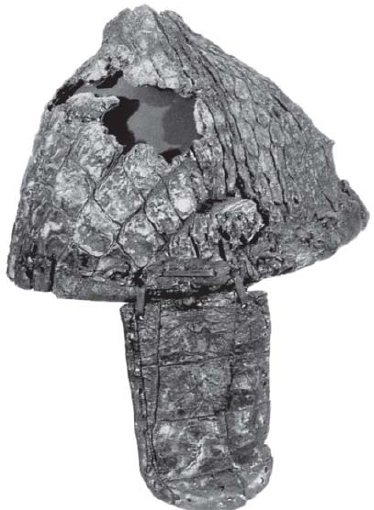
One of two medieval helmets made from crocodile skin, found in Nubia near the frontier between Egypt and Sudan. These were probably typical of the sort of protection worn by the Nubian raiding forces that menaced southern Egypt during the early years of Saladin’s reign. (Staatliche Museen Berlin; J. Laurentias photograph)
Of all his astonishing military campaigns, none was more remarkable than the one he launched, but did not personally lead, during the winter of 1182–83. According to the Crusader chronicler Ernoul, Reynald had five galleys whereas other sources seem to indicate a small squadron of between five and ten ships, probably of varied types taken as prefabricated parts to the Red Sea.
The choice of the port of ‘Aydhab, close to what is now the border between Egypt and Sudan, as the primary target for Reynald’s fleet showed a detailed knowledge of the trade and pilgrim routes. It is also one of many factors that prove the raiders had local support from sailors or merchants with detailed local knowledge. If Reynald’s raids had succeeded they might effectively have split the Islamic world in two. They would certainly have had a huge impact upon Muslim trade with India and might even have opened up direct links between Mediterranean Europe and the Indian Ocean three centuries before the great Age of Discovery. Saladin probably had more immediate concerns, such as the possibility of Reynald linking up with lingering pro-Fatimid elements in Upper Egypt, Nubia and Yemen, not to mention the threat of a real (rather than imaginary) alliance between the Christian Crusader states and the Christian African kingdoms of Nubia and Ethiopia. In reality Reynald of Châtillon’s astonishing strategic vision went beyond his military capabilities. The raids failed, and only served to reinforce Saladin’s determination to crush the Crusaders once and for all. They also contributed to the sultan’s personal anger with the Lord of Oultrejordain, whom he is credited with killing – or at least striking the first blow – after the battle of Hattin.
Amalric was the son of Fulk of Anjou and Queen Melisende of Jerusalem, and the younger brother of King Baldwin III. His first significant position of authority was as Count of Jaffa, which he held for only one year because he quarrelled with his brother, the king. Baldwin restored the lands of Jaffa and added those of Ascalon around 1154. Amalric himself came to the throne nine years later and spent the greater part of his reign attempting with some success to strengthen the Crown of Jerusalem financially, legally, politically and militarily. In fact he is widely seen as one of the Crusader Kingdom’s more successful rulers.
Much of his attention was focused upon Egypt, where the declining Fatimid Caliphate held out the possibilty of huge wealth and territorial expansion. However, Nur al-Din of Syria was similarly aware of Egypt’s potential and this resulted in a remarkable series of campaigns for control of Egypt by these competing rulers. For King Amalric they were often undertaken in alliance with the Byzantine Empire and included a number of bitter sieges. For example, after Shirkuh and Saladin’s victory over the army of the Fatimid and Kingdom of Jerusalem alliance at the battle of al-Babayn, Shirkuh withdrew to Alexandria, which was his main base in Egypt.
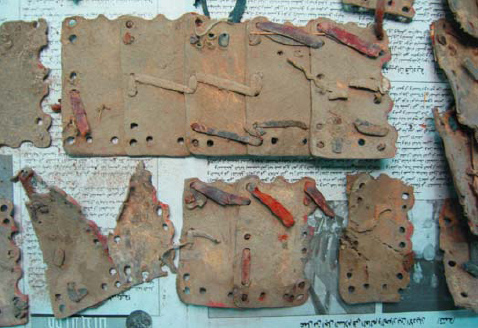
Amongst the most important recent discoveries to shed light on Middle Eastern Islamic military equipment from the time of the Crusades is a hoard of material from a forgotten stairwell in the Citadel of Damascus. (Syrian National Museum Conservation Department, Damascus; author’s photograph)
Fearing that food supplies might still reach Shirkuh’s army from southern Egypt, King Amalric left some ships in Cairo before heading for Alexandria. He then made camp between Kum Trugah and Damanhur, some 60km from the great Egyptian seaport. Perhaps he was waiting for scouts to report on the situation at Alexandria or perhaps he feared that the water level in the Alexandria Canal was too low for his ships. Certainly the level of the Nile continued to drop until the annual Nile flood. Meanwhile Shirkuh decided to split his forces and left Saladin to defend Alexandria while he himself returned south with the bulk of the army.
Once King Amalric knew that Shirkuh had slipped past him, he set off in pursuit, joining his ally the Fatimid wazir Shawar in Cairo. The King of Jerusalem then had second thoughts when he learned that there was fear of famine in Alexandria and so returned to press the siege. It lasted from early May to 4 August and involved a close bombardment by mangonels as well as a tight blockade. Nevertheless the local inhabitants continued to support Saladin and his troops. Many foreign merchants also helped in the defence of Alexandria while Nur al-Din launched diversionary raids against the Crusader states in Syria. Far to Amalric’s rear, Shirkuh continued to campaign in Upper Egypt but eventually had to return north and start negotiations for a truce. The situation in Alexandria was now serious and consequently Shirkuh and the Syrians made the most concessions.
Saladin’s immediate concern was to get his sick and injured safely back to Syria, and according to a study by the Egyptian historian Professor Omran: ‘He asked Amalric to let him have them taken off by ship, but when they reached Acre those who had recovered were made to work in the sugar-plantations and it was only after Amalric had intervened in person that they were allowed to depart for Damascus.’10
In fact the failure of Amalric’s Egyptian plans resulted in it becoming the base for a new and even more threatening power, namely that of Saladin. Amalric died in July 1174, only a few weeks after Nur al-Din, and his heir was a child who already suffered from leprosy, the tragic King Baldwin IV.
King Richard I of England, known as Coeur de Lion or the ‘Lion Hearted’, was actually French. Born in 1157, he learned the skills of administration and of war as governor of the vast fiefdom of Aquitaine on behalf of his father King Henry II. However, Richard of Poitou as he was then widely known, was not a dutiful son. He rebelled against his father in 1173–74 and again in 1189, but that same year King Henry II died and Richard became ruler of England and a great part of south-western France.
Richard’s motivation, like his sexuality, has been the subject of heated academic debate. Like his great rival, King Philip Augustus of France, King Richard used crusading as a means of enhancing his own reputation. In fact he ‘took the cross’ by declaring in public his intention of going on crusade to regain the Holy Land from Saladin before his father Henry died. Although this proclamation earned King Richard respect within his own realm, it would be probably be wrong to see it merely as a political ploy or a warlike adventure. As the historian D. Carpenter wrote: ‘For someone often prey to a morbid sense of his own sinfulness, the spiritual benefits of the crusade, with the promise of remission of all sins, were compelling. So was the chance to exercise martial talents … not against fellow Christians but against the infidels.’11 Without doubt it was King Richard of England rather than King Philip of France who welded the disparate forces of the Third Crusade into a potent fighting force under his leadership, largely through his obvious charisma and considerable knowledge of warfare.
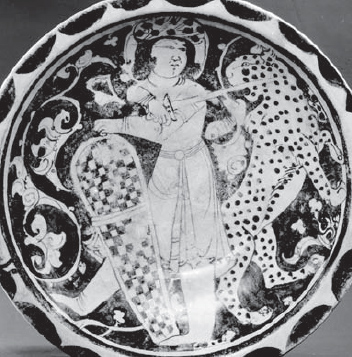
Medieval Islamic art often shows military figures on foot, but they were usually dismounted cavalrymen. (Keir Collection, London)
On the other hand, Richard took the ruthlessness that he had learned in Europe with him on his crusade. When the exhausted garrison of Acre surrendered in July 1191, ransom arrangements for the captured men were agreed. However, there were delays in payment so King Richard had the great majority of prisoners and their families slaughtered in full view of Saladin’s scouts. The latter tried to intervene but were too few to save their comrades, while the bulk of Saladin’s army was too far away to help.
After his victory outside Arsuf, Richard clearly hoped to advance against Jerusalem. Here, however, Saladin had the fortifications repaired, fully manned and put into a state of defence. Both leaders sought to inspire their men by setting a personal example. Whereas Richard was frequently in the front line of battle, Saladin carried masonry for the defences of Jerusalem on the saddle of his horse. Clearly both sides suffered badly from the winter, but things seem to have been worse for the Crusaders, especially when Richard attempted to advance towards Jerusalem through rain and mud. Harassed by the Muslims and unable to go farther, Richard eventually ordered a withdrawal on 8 January 1192.
The final months of the Third Crusade witnessed some tactically interesting skirmishing and ambushes, but military operations were now on a small scale. Diplomacy and negotiation became more important, and these were fields in which Saladin held mastery over Richard.
9 Ibn al-Athir, op. cit., p. 236.
10 Omran, M. S., ‘King Almaric and the Siege of Alexandria, 1167’, in Edbury, P. W. (ed.), Crusade and Settlement (Cardiff, 1985) p. 195.
11 D. Carpenter, The Struggle for Mastery, Britain 1066–1284 (London, 2003) p. 246.